Ocular Surface Disorders: Challenges and Innovations
*Corresponding Author: Fiyona Stepiton, Department of Ophthalmology, University of Colorado Anschutz Medical Campus, United States, Email: stepiton@yahoo.comReceived Date: Nov 02, 2024 / Published Date: Nov 30, 2024
Citation: Fiyona S (2024) Ocular Surface Disorders: Challenges and Innovations. Optom Open Access 9: 290.DOI: 10.4172/2476-2075.1000290
Copyright: © 2024 Fiyona S. This is an open-access article distributed under the terms of the Creative Commons Attribution License, which permits unrestricted use, distribution, and reproduction in any medium, provided the original author and source are credited.
Abstract
Ocular surface disorders (OSDs) are a growing public health concern affecting millions globally, encompassing conditions like dry eye disease and ocular surface inflammation. The multifactorial nature of OSDs is influenced by environmental factors, systemic conditions, and modern lifestyle choices, complicating diagnosis and management. This perspective article explores the challenges associated with the subjective nature of symptoms, the limitations of traditional treatment modalities, and the need for standardized diagnostic criteria. Furthermore, it highlights innovative approaches such as advanced diagnostics, novel therapeutic agents, and the importance of patient education and lifestyle modifications. Embracing a multidisciplinary approach in managing OSDs is essential for improving patient outcomes and enhancing the quality of life for affected individuals.

 Spanish
Spanish  Chinese
Chinese  Russian
Russian  German
German  French
French  Japanese
Japanese  Portuguese
Portuguese  Hindi
Hindi 